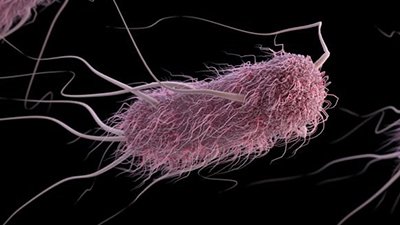
Aren’t 250 Million Year Old Live Bacteria a Bit Much?
We are being bombarded by numerous scientific reports describing the discovery of ‘living’ organisms or parts of organisms in ‘old’ rocks.
We are being bombarded by numerous scientific reports describing the discovery of “living” organisms or parts of organisms in “old” rocks. For instance, bacteria have been resuscitated from soils and vegetable matter trapped for a supposed 25 to 35 million years in amber.1 They have also been isolated from insects trapped in amber dated 25 to 135 million years old.2 Amber is fossilized tree resin that sometimes contains the remains of insects that became trapped.3 The preservation of the insects, which sometimes are identical to modern forms, is often excellent.
Red blood cells were surprisingly discovered in bones of Tyrannosaurus rex at Montana State University in Bozeman 4 [see also Dinosaur Soft Parts]. Furthermore, in the well-preserved dinosaur skeletal parts, the bone was “…almost indistinguishable from modern bone, with no mineral infilling”.5
DNA has also been extracted from insects in amber, but many scientists are skeptical,6 while many others have accepted the results. Hong Yang, who has sequenced mitochondrial DNA from mammoths and mastodons, believes that under special conditions DNA can survive many millions of years. Scientists previously believed that the DNA molecule “…seemed too fragile to be preserved in the fossil record”.7
DNA also has been claimed to have been extracted from a dinosaur.8 The DNA is identical to, of all organisms, a turkey! Some scientists have accepted this strange result because of their strong desire to link dinosaurs with birds. Others think contamination is obviously the answer, perhaps from a turkey sandwich eaten in the lab. The investigators supposedly have ruled out contamination. The original researchers, however, are also skeptical of the results, especially since the dinosaur was a Triceratops and not a theropod from which birds supposedly evolved. The discoverer further states that finding dino DNA is “…for most people a truly heretical idea”.9
One wonders how these bacteria and delicate molecules could survive long periods of time?
Survival now pushed back to 250 million years
If this isn’t enough, a recent report claims to have isolated and revived salt-resistant bacteria from a salt inclusion dated 250 million years old, doubling the length of time bacteria can survive trapped in rocks!10 A salt inclusion is a pocket of brine trapped as the salt crystallized. Contamination is always a concern and critics usually claim this in order to dismiss such reports. Hazen and Roedder challenge this research by claiming recrystallization.11 The researchers, however, took great pains to make sure their samples were not contaminated, and that the salt was not recrystallized.12,13 The date of the formation is another area of attack by critics, but the formation is from the Delaware Basin of west Texas, supposedly well-dated by invertebrate fossils and radiometric dating within the unifomitarian system.
The organisms more likely are young
The researchers admit that they do not know how the bacteria could survive 250 million years. Some scientists refuse to believe that any organism and can survive for eons.14 Others marvel that the survival of organisms for millions of years is incredible. Meanwhile, the discoverers of “250 million year old live bacteria” speculate that their simple metabolism will provide clues for the evolution of life and of how bacteria could survive in space or on other bodies of the solar system.15 In a report of this discovery in Science News, it was revealed that a scientist, back in the 1960s, probably discovered live bacteria in salt deposits more than 500 million years old within the uniformitarian system.16 The report was dismissed as impossible back in the 1960s but is being seriously considered now.
It truly is astonishing that bacteria, DNA, red blood cells, bone proteins, etc. could really survive the vicissitudes of tectonics, heating events, water seeping through the rocks, and other geological processes for millions of years and remain “alive.” Before this barrage of discoveries, scientists considered that such survival was impossible past several thousand or tens of thousands of years. The evidence sits much more comfortably within the young-Earth Creation/Flood model. The bacteria and parts of organisms are really “young” (i.e. only a few thousand years old), as scientifically expected.
Footnotes
- Anonymous, Amber alien surprises Lazarus team. New Scientist 154(2082):7, 1997.
- Monastersky, R., Ancient bacteria brought back to life. Science News 147:308, 1995.
- Poinar, Jr., G.O., Life in Amber, Stanford University Press, Stanford, CA, 1992.
- Hecht, J., Dinosaur bones yield blood protein. New Scientist 154(2087):16, 1997.
- Hecht, J., Dinosaur bones yield blood protein. New Scientist 154(2087):16, 1997.
- Sykes, B., Lights turning red on amber. Nature 386:764-765, 1997.
- Yang, H., DNA sequences for paleontologists: new challenges from old molecules. Palaios 12(3):3-4, 1997.
- Holden, C., Dinos and turkeys: connected by DNA? Science 288:238, 2000.
- Holden, C., Dinos and turkeys: connected by DNA? Science 288:238, 2000.
- Vreeland, R.H., Rosenzweig, WD, and Powers, D.W., Isolation of a 250 million-year-old halotolerant bacterium from a primary salt crystal. Nature 407:897-900, 2000.
- Hazen, R.M. and Roedder, E., How old are bacteria from the Permian age? Nature 411:155, 2001.
- Vreeland, R.H., Rosenzweig, WD, and Powers, D.W., Isolation of a 250 million-year-old halotolerant bacterium from a primary salt crystal. Nature 407:897-900, 2000.
- Powers, D.W., Vreeland, R.H., And Rosenzweig, W.D., How old are bacteria from the Permian age? - reply. Nature 411:155, 2001.
- Travis, J., Prehistoric bacteria revived from buried salt. Science News 155:373, 1999.
- Travis, J., Prehistoric bacteria revived from buried salt. Science News 155:373, 1999.
- Travis, J., Prehistoric bacteria revived from buried salt. Science News 155:373, 1999.
Recommended Resources

Answers in Genesis is an apologetics ministry, dedicated to helping Christians defend their faith and proclaim the good news of Jesus Christ.
- Customer Service 800.778.3390
- Available Monday–Friday | 9 AM–5 PM ET
- © 2025 Answers in Genesis





